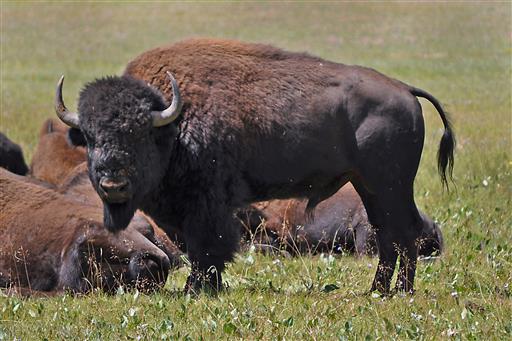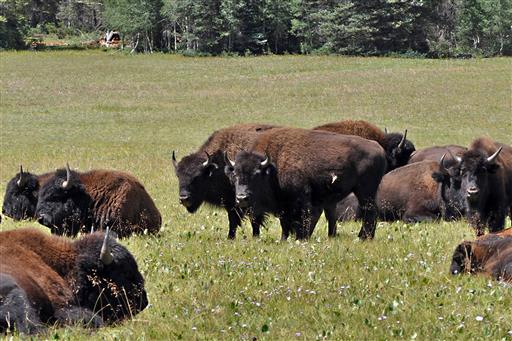
|
| This Aug. 26, 2010, file photo provided by the Kaibab National Forest shows bison in the national forest adjacent to the Grand Canyon in Northern Arizona. The hundreds of bison that roam the far northern reaches of Arizona are descendants of the massive animals brought to the region in the early 1900's as part of a crossbreeding operation. But a new report issued Thursday, June 16, 2016, by the National Park Service says that’s just a snapshot of bison history in the region. (Kaibab National Forest via AP, File) |
FLAGSTAFF, Ariz. (AP) — The effort to come up with a way to manage bison at Grand Canyon National Park has taken a turn back in time — thousands of years — to determine the massive animals' roots.
A new National Park Service report declares bison are native to the area and says they perhaps arrived sporadically in small, dispersed herds over the past 11,000 years. The designation means authorities can cull the beasts that have been damaging the landscape but not remove them entirely from the park.
The study released Thursday acknowledges the current herd descends from bison that were brought to northern Arizona in the early 1900s by a rancher who wanted to crossbreed them with cattle. But that's just a snapshot of the animal's history in the region, the report says.
Bison historically weren't a dominant part of the landscape. But they did appear in the area, which was the edge of their historic range, said Glenn Plumb, acting chief of science and resource management at the Grand Canyon and one of nine wildlife biologists who authored the report.
"All the evidence shows that northern Arizona was not a black hole for bison," he said. "It was part of the narrative; the habitat was suitable for them."
The study replaces an internal report meant to inform efforts to quickly reduce the burgeoning population from as many as 600 animals to between 80 and 200, and come up with a long-term strategy to manage the bison and have a huntable population outside the Grand Canyon.
The animals that can weigh 2,000 pounds or more are trampling vegetation, grazing in pristine meadows and polluting water sources in the park, officials say.

|
| This Aug. 26, 2010, file photo provided by the Kaibab National Forest shows bison in the national forest adjacent to the Grand Canyon in Northern Arizona. The hundreds of bison that roam the far northern reaches of Arizona are descendants of the massive animals brought to the region in the early 1900's as part of a crossbreeding operation. But a new report issued Thursday, June 16, 2016, by the National Park Service says that’s just a snapshot of bison history in the region. (Kaibab National Forest via AP, File) |
Environmental groups say the internal report and the new study are not grounded in science and marked a surprising change in the Grand Canyon's onetime classification of bison as nonnative.
Jeff Ruch, executive director of Public Employees for Environmental Responsibility, said the new report reaches an absurd conclusion that possible ancient sightings of bison in small numbers make the current herd native to the park.
"That is the leap that is hardest for everyone to swallow," he said Thursday. "This was a group of animals, imported, bred with cattle, part of the commercial enterprise and don't fit most people's idea of what native wildlife would be."
In 1906, a rancher brought dozens of bison to northern Arizona to crossbreed them with cattle. But the operation produced no male calves and was abandoned. The state now manages the animals.
The report points to various factors as evidence of the animals' previous existence in the region: a 2010 survey of bison in North America, bison remains recently discovered at a 3,000 year-old hunting site in southern Arizona, and oral stories from American Indian tribes.
According to a Hopi story, Ute tribal members bestowed a herd of bison as a gift during a visit to the northeastern Arizona reservation, and it is remembered through dances today. Paiute tribes have names for the buffalo, and one story recorded by explorer John Wesley Powell describes an encounter between a porcupine and buffalo, the report says.
Ruch contends the report reached what appears to be a predetermined management decision that up to 200 bison can be supported in the Grand Canyon. He contends the Park Service is aligning interests with the Arizona Game and Fish Department to appease hunters.
Hunting tags for bison are the most sought-after of the state's big game species on lands adjacent to the Grand Canyon. Arizona U.S. Sen. John McCain has said he wants state-licensed hunters to be able to participate in any effort to cull the population and be allowed to keep the meat.
Visitors can see bison on the drive to the Grand Canyon's North Rim, sometimes grazing near the park entrance gates. The animals have been spending more time within the Grand Canyon where they can't be hunted, but they rarely, if ever, go below the North Rim, wildlife officials say.
In recent years, the Park Service has focused on restoring and sustaining wild bison populations across the central and western United States. Plumb said state, federal and tribal officials envision a 215,000-acre area of northern Arizona where bison can roam free, including on 54,000 acres of the Grand Canyon.
Millions of bison once roamed the Great Plains, but the number has dwindled to around 500,000 in the U.S. Few bison herds roam freely in areas including Utah and Arizona, with the largest wild population in Yellowstone National Park.
Copyright 2016 The Associated Press. All rights reserved. This material may not be published, broadcast, rewritten or redistributed.
Page created on 6/21/2016 4:52:57 AM
Last edited 6/21/2016 4:52:57 AM


